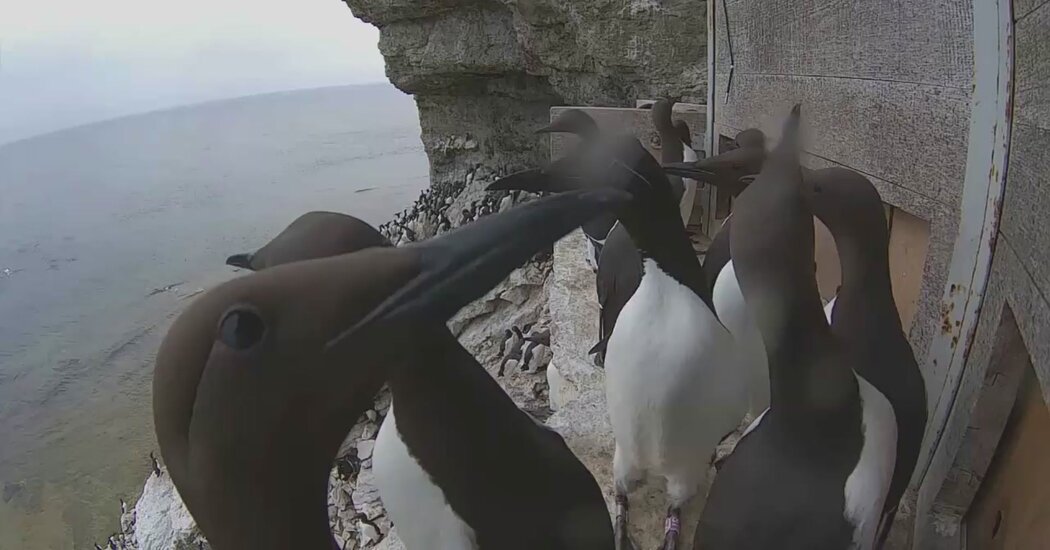When vacationers occur to Stora Karlso, a limestone-ledged character reserve off the coast of Sweden, they keep a respectful length from the several seabirds that call the island household. Like most readers to wild places, they purpose to go away only footprints and take only pics — to slip amongst the strands of the world wide web of everyday living they’ve arrive to see.
No these types of luck. In a paper posted this month in Biological Conservation, researchers depth how the sudden absence of travelers on Stora Karlso for the duration of the pandemic established off a astonishing chain reaction that wreaked havoc on the island’s colony of prevalent murres, diminishing its population of newborn birds.
Stora Karlso became a nature reserve in the 1880s, soon after countless numbers of a long time of human profession. Its common murre populace — which when was diminished to less than 100 for the reason that of looking and egg foraging — is now all-around 60,000 birds, and is the biggest in the Baltic Sea.
Jonas Hentati-Sundberg, a researcher at the Swedish College of Agricultural Sciences and the direct creator of the new paper, has been researching the colony for 19 many years. When he and his crew started arranging the 2020 analysis time, they predicted the pandemic would existing logistical hurdles: Without visitors, less boats would be functioning, and the island’s cafe would be shut.
“These have been our principal ideas,” he mentioned.
Even so, from their initially excursions of the yr, in late April, they recognized that the murres “were flying off all the time,” with folks from time to time disappearing for times. That was a transform in behavior, he said, and a sign that a thing was building the birds a lot more anxious than usual.
The island’s white-tailed eagles also changed their actions. Ordinarily, seven or eight eagles will devote the winter season there, and then head out as checking out period picks up in the spring, Dr. Hentati-Sundberg explained.
But devoid of the inflow of holidaymakers, they stuck around, and far more eagles joined them — from time to time dozens at a time. “They will get in areas exactly where there is a good deal of food stuff and minor disturbance from people,” he mentioned. “This year, this was their very hot location.”
Further observation clarified the new dynamics: The eagles, freed from the bothersome existence of humans, were on their own bothering the murres.
Even though eagles seldom prey on murres, the seabirds dread them, and scatter at the slightest flyby. In 1 online video from May possibly, a distant, broad-winged figure sends hundreds of murres hooting and cascading off their ledges, like theatergoers speeding out of balconies following the curtain simply call.
This transpired about and above. From May well 1 to June 4, birds in 1 component of the colony ended up displaced from their nests by eagles for an common of 602 minutes for every working day — significantly lengthier than 2019’s regular of 72 minutes.
In addition to time, the murre colony misplaced eggs, kicking them off ridges through panicked takeoffs, or leaving them vulnerable to hungry gulls and crows. Twenty-six % fewer eggs hatched in 2020 than was common for the rest of the ten years.
“Emotionally, it’s a bit tricky to chew,” Dr. Hentati-Sundberg reported.
Researchers across the earth have taken advantage of pandemic-connected vacation constraints to analyze the results of unexpected human absence on the organic environment, an occasion some have named the “anthropause.” A getting like this, exactly where a tourism stoppage has a domino-fashion impact on several species, is “fascinating,” said Nicola Koper, a professor of ecology at the College of Manitoba who was not included in the investigation. “This demonstrates just how impactful our improvements in journey have been on complete ecosystems.”
For Dr. Hentati-Sundberg, a summertime on a modified Stora Karlso emphasized how tightly we can be entwined with other species — even when we see ourselves as mere observers — and that “understanding our associations with mother nature and embracing the idea of ourselves as a section of the photograph is a additional fruitful strategy” for conservation selections.
“Stepping again is not an option,” he mentioned. “We are out there.”
